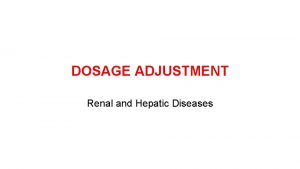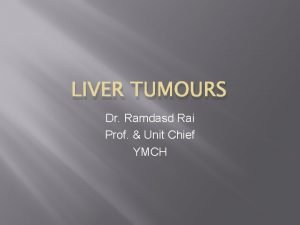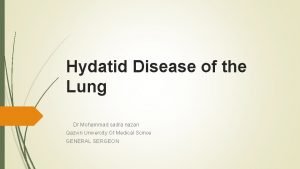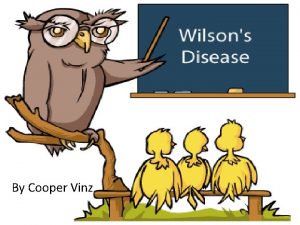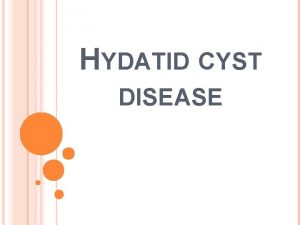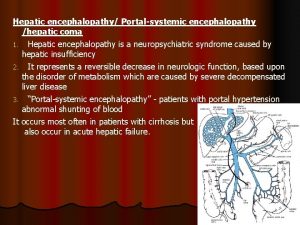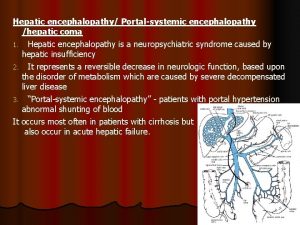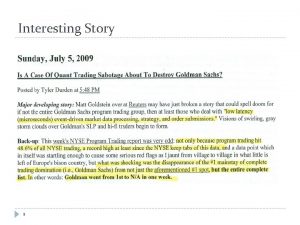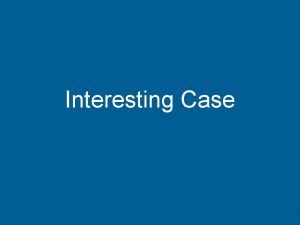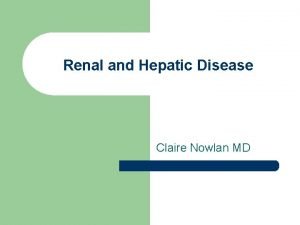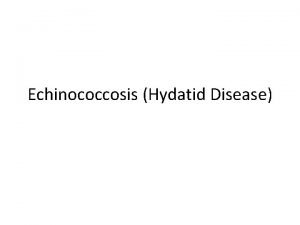Interesting Case Hepatic Renal Hydatid Disease Dr P













- Slides: 13

Interesting Case: Hepatic & Renal Hydatid Disease Dr P Jarvis, ST 4 Radiology Registrar Peninsula Radiology Academy Dr M Puckett, Consultant Radiologist Torbay & South Devon NHS Foundation Trust

Clinical Information • 58 year old gentleman who has lived in UK for 1 -2 years • PMH: Gallstones • Presented to his GP with: • • Abdominal discomfort Passing debris in urine Hb WCC Neut Lymph Eosino CRP 130 [130 -180] 13. 4 [4 -10] 5. 2 [1. 8 -7. 5] 5. 9 [1 -4] 1. 3 [0 -0. 4] 5 [0 -5] • Regularly visits his home in rural Bulgaria where he keeps animals including horses and sheep • Referred for an abdominal ultrasound

Left kidney: Multiple cysts of varying size with thick septae Ultrasound Scan Right kidney: Normal

CT • Two lesions: • One in left lobe of liver • One in left kidney

CT Liver Lesion • • • Kidney Lesion Large multi-septated cystic lesions Thick enhancing septae Almost no right renal parenchyma remaining Differential Diagnosis: • Cystic Renal tumour with deposit in liver • Hydatid disease

Final Diagnosis • Given exposure risks and imaging appearances, hydatid disease strongly suspected • Hydatid Serology: • Strongly positive for Echinococcus (0. 991, cut off 0. 251) Diagnosis: Hepatic and Renal Hydatid disease

Key Learning Points • Careful identification of lesion origin on ultrasound (liver lesion not identified initially at US) • Consider patient risk factors when forming differential diagnoses • Extrahepatic hydatid disease is rare but should be considered in those with potential exposure

Discussion • Hydatid disease is a zoonosis caused by the larvae of the Echinococcus tapeworm • Two main species: • Echinococcus granulosus (more common) • Echinococcus alveolaris/multilocularis (less common, more invasive) Adult Echinococcus Granulsosus 1 1) https: //www. webpathology. com/image. asp? case=954&n=20

Lifecycle of E. granulsosus Tapeworm lives in small intestine Sheds ova in faeces Definitive Host (dog or other carnivore) Cysts in viscera ingested Hydatid cyst formed in liver, lungs etc. Intermediate Host (usually sheep) Ova in faeces ingested Penetrates intestinal wall to portal venous or lymphatic system Human becomes unwitting intermediate host

Hydatid Cyst Appearances Imaging from the case Gross pathology example 2 Multiple daughter cysts Unilocular Collapsed wall of the outer cyst Large outer cyst Daughter cysts Multiple daughter cysts Calcified Stages of cyst formation 3 2) Case courtesy of Dr Dharam Ramnani, Radiopaedia. org, r. ID: 29673 3) Case courtesy of Dr Pujanwita Das Majumder, Radiopaedia. org, r. ID: 27166

Location of Hydatid 4 cysts • Liver 75% (as most commonly via portal venous circulation) • Lungs 15% • Kidneys 2 -3% - rare • Spleen 0. 9 -8% • Bone 0. 5 -4% • Can occur anywhere 4) Pedrosa I, Saíz A, Arrazola J et-al. Hydatid disease: radiologic and pathologic features and complications. Radiographics. 20 (3): 795 -817.

Treatment Options • Albendazole (used for a variety of parasitic worm infections) • Surgical resection - likely in this case given the size and symptoms • Needle biopsy contraindicated: • Accidental entry of cyst fluid into the circulation cause anaphylactic shock

Thank you
 Ira pré renal renal e pós renal
Ira pré renal renal e pós renal Diagnostico etiologico
Diagnostico etiologico Maintenance dose formula
Maintenance dose formula Interesting more interesting the most interesting
Interesting more interesting the most interesting Vasa recta vs peritubular capillaries
Vasa recta vs peritubular capillaries Wormbase
Wormbase Cestodlar
Cestodlar Camellotte
Camellotte Pair for hydatid cyst
Pair for hydatid cyst Hydatid cyst
Hydatid cyst Uremia pathogenesis
Uremia pathogenesis Interesting facts about wilson's disease
Interesting facts about wilson's disease Best case worst case average case
Best case worst case average case Bharathi viswanathan
Bharathi viswanathan


